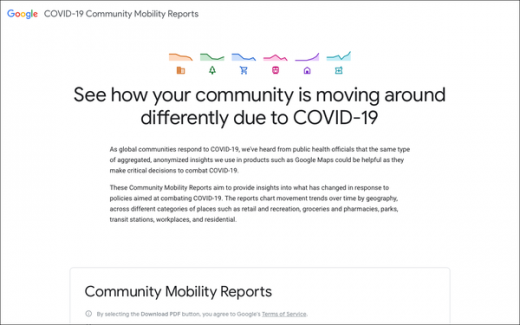Google, Others Use Location History Data To Track Peoples’ Movements During Pandemic
Google, Others Use Location History Data To Track Peoples’ Movements During Pandemic

Alphabet’s assistance to the U.S. government and public health officials doesn’t stop with its Verily Life Sciences subsidiary. Sibling Google is allowing the use of its mobile location data used in ad targeting to track people’s movements amid the COVID-19 pandemic.
Google announced the move early Friday with the release of its COVID-19 Community Mobility Report that shows how it uses data from people who have opted in to storing their location history.
“Starting today we’re publishing an early release of our COVID-19 Community Mobility Report to provide insights into what has changed in response to work from home, shelter in place, and other policies aimed at flattening the curve of this pandemic,” Jen Fitzpatrick, SVP of GEO, and Karen DeSalvo, chief health officer at Google Health, wrote in a blog post. These reports have been developed to be helpful while adhering to our stringent privacy protocols and policies.”
The report shows trends over several weeks that represent peoples’ movements during the 48 to 72 hours prior.
The trends show aggregate anonymized data to chart movement trends by geography, across different high-level categories of places such as retail and recreation, groceries and pharmacies, parks, transit stations, workplaces, and residential.
The report will initially cover 131 countries and regions. To protect people’s privacy, no personally identifiable information — such as an individual’s location, contacts or movement — is made available at any point, the company wrote.
While the data provides insight into how people are listening and adhering to government instructions to shelter in place and, when possible, work from home, some residents of rural communities across Wyoming were outraged when Forbes released a map giving Wyoming, Montana and others a grade of “F” grade for the amount they travel from their homes. In a local forum, they point out the distance required to travel to get essential supplies and groceries. Some who have livestock not on their adjacent property to their home say they need to travel five miles or more to feed them.
Google is not the only company releasing tracking location data that could be used to target ads. Cuebiq and OnAudience.com also have similar data.
Cuebiq’s data reveals that residents of Florida, the Southeast and elsewhere continue to travel widely, potentially exposing more people as the COVID-19 outbreak accelerates, while Americans in the West, Northeast and Midwest have complied with orders from state and local officials to stay home.
London-based OnAudiance.com CEO Maciek Sawa during an interview said many advertising agencies such as GroupM, Mindshare, and Publicis, as well as universities and research companies, use its location data to serve ads, but the company found it also can accurately identify movement globally.
“When COVID-19 hit we thought about how else to use the data,” he said, stopping short of admitting that the data could predict future outbreaks in certain regions. “That would require more data.”
Sawa said that contrary to the belief of some, the world did not stay still and residents did not stay at home. The analysis of data from about 2.2 billion mobile devices in the U.S., Canada, Japan and European countries provide that proof.
People who came into the U.S. from other countries just prior to the travel restrictions are mainly staying on the East Coast. The greatest mobility can be observed in New York and the surrounding areas, as well as in main population centers of the West Coast like Los Angeles and San Francisco.
“We want to provide the information that’s needed and missing,” he said. “We want to identify the most risky who could potentially spread the virus. Now it’s about movement.”
(16)


